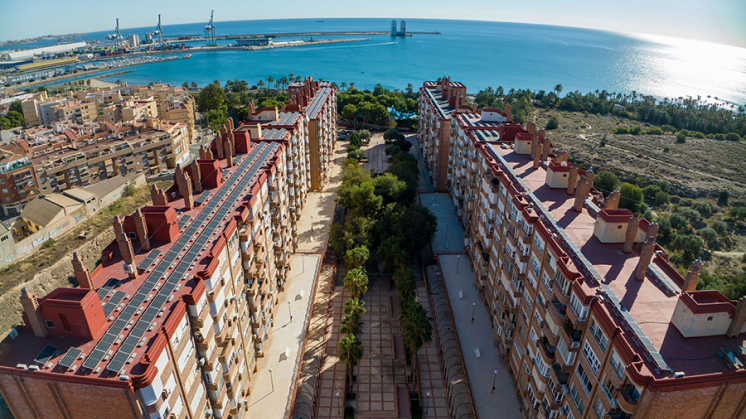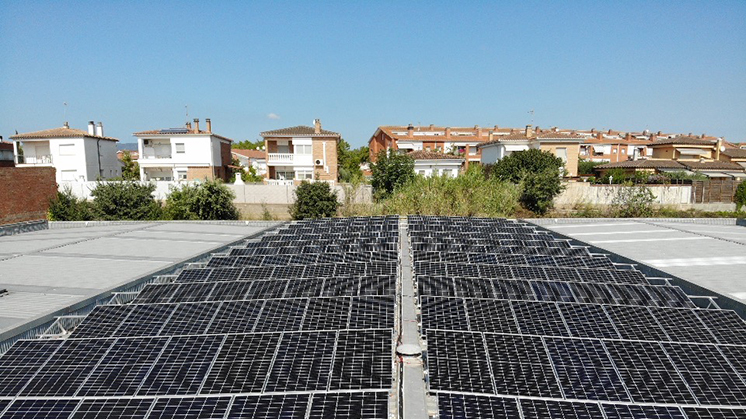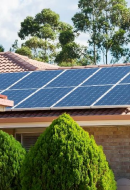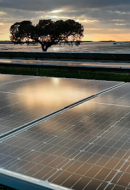Solar Communities
What are solar communities and how do they work?
Solar communities allow people to enjoy all the benefits of solar energy, without the need for photovoltaic panels on their own roofs. It is a booming new business model that not only helps to save on bills but also contributes to the decarbonisation of the planet.

The homeowners' community of El Palmeral enjoys the largest Iberdrola España Solar community in Alicante, Spain.

The Domeny-Taialà neighbourhood has the first Iberdrola España solar community in Girona, Spain.
Since 2000, the share of renewable energy has increased considerably. According to a report by the energy think tank Ember, green energy has risen from 19 % of the world's energy to more than 30 %. This milestone is mainly due to the increase of solar and wind energy from 0.2 % worldwide in 2000 to a record 13.4 % in 2023. In the case of the European Union, for example, this increase has been even greater since, according to the same report, solar and wind reached a share of 27 % in 2023.
Photovoltaic solar energy has been the fastest growing energy source for almost two decades. The 'Renewable Energy Market Update' report by the International Energy Agency (IAE) points out that this growth is expected to continue setting records and highlights the importance of self-consumption in countries such as Spain, Germany, the Netherlands, France, Italy and Sweden, where there is a drive for a significant change in the adoption of distributed photovoltaic systems.
Solar communities, or collective self-consumption, are extremely important, as they enable photovoltaic energy to be distributed to a larger number of people, allowing them to benefit from solar power without having to make an investment or to have solar panels on their roofs.
What are solar communities?
But let's start at the beginning: what exactly are solar communities? Solar communities are photovoltaic installations that produce solar power by placing solar panels on the roofs of buildings. The energy generated is distributed to the different participants within a radius of up to 2 km. That way, users can enjoy the multiple advantages of a clean and sustainable energy source without having to install solar panels on their homes.
How do solar communities work?
Solar energy communities work in a similar way to other community projects. Let's imagine a community garden created by a group of neighbours on a common piece of land because not everyone has a plot, where everyone contributes a small investment to buy seeds, tools and other necessary resources. What the garden produces is then distributed among the participants according to their contribution. In the same way, a solar community installs solar panels on the roof of the community of neighbours or in a common place and the energy generated is shared among the members.
Those who want to participate in this solar community can sign up by purchasing a portion of the system's capacity either through purchasing panels or by simply acquiring a share in the total energy production. This allows each member to profit from the electricity generated, adjusting the amount of energy according to their needs. If more is consumed than their share covers, the difference is paid at the utility's regular rate. If less is consumed, the surplus electricity is fed into the grid and purchased by the utility, lowering their bill and reflecting the savings in energy from solar sources.
In this way, solar communities make it easy to access solar energy in a shared and collaborative way, cutting down on electricity bills and promoting the wider use of renewable energy.

Photovoltaic solar panels
What they are, types of panels and how they work.

Photovoltaic energy terms
Top 10 terms to know about photovoltaic energy.

Photovoltaic self-consumption
Discover this ally in the fight against climate change.

What is solar energy?
A sustainable and clean alternative to polluting energy sources.
Benefits of solar communities
Solar communities offer a wide range of benefits, from economic and environmental to social and technological. Let’s take a look at the main ones.
In short, solar communities are an innovative and affordable solution to promote the use of renewable energy. They facilitate access to solar energy for a wide range of people and organisations, reduce energy costs and carbon emissions, and foster cooperation and local economic development. As awareness of the benefits of clean energy grows, solar communities are becoming a crucial part of the transition to a more sustainable and equitable future.
Types of solar energy communities at Iberdrola
At Iberdrola, we have been committed to renewable energies for years. With Iberdrola’s solar communities, we match available rooftops with customers who want to consume solar energy without having to make the investment or install it on their own homes. In addition, we do this with a subscription model whereby customers within 2 km of a solar community can save on their bills with local, sustainable energy, digitally, easily and without having to agree among themselves.
This is a new model of collaborative and local energy consumption that not only saves money but also helps the planet. We have two types of solar communities:
Customer Solar Community
Customer solar communities are those where it’s the customer (or customers) themselves who invest in their installation, becoming their owner and deciding how to distribute the energy generated in their solar community. In these cases, Iberdrola takes care of the installation, commissioning, monitoring, legal footwork and paperwork necessary to put the installation into operation.
The typical example is homeowners' or condo associations, for which, moreover, there are rebates in the form of taxes and fees in many municipalities that want to encourage this type. A solar community installs solar panels on the roof of the building and the energy generated is distributed among the members according to each one’s stake in the installation.
All neighbours who want to participate in this solar community can do so by acquiring a percentage share in the photovoltaic installation. This type of solar community requires an agreement on the part of the neighbours as to how to make the investment and the distribution of the solar energy generated.
Iberdrola investment solar community
Iberdrola investment solar communities are those where Iberdrola makes the investment for their installation. Iberdrola is the owner of the photovoltaic panels and is in charge of marketing the solar energy generated to other participants.
All those who want to participate in this solar community can do so easily online by subscribing to the solar service. Based on this subscription fee, the percentage of participation in the solar community will be higher or lower. In this way, each member gets a share of the clean energy generated, which saves them money on their electricity bill.
Iberdrola pays annual rent to the owner of the rooftop, who also has priority access as a participant in the solar community, as well as reinforcing its image and brand by having a positive impact on the surrounding area.
These types of solar communities are ideal for rooftop owners who have more roof surface than they need to satisfy their own consumption, but do not have the capacity or interest in making their own investment. This is the case of schools or industrial buildings that are close to homes and residential areas.







